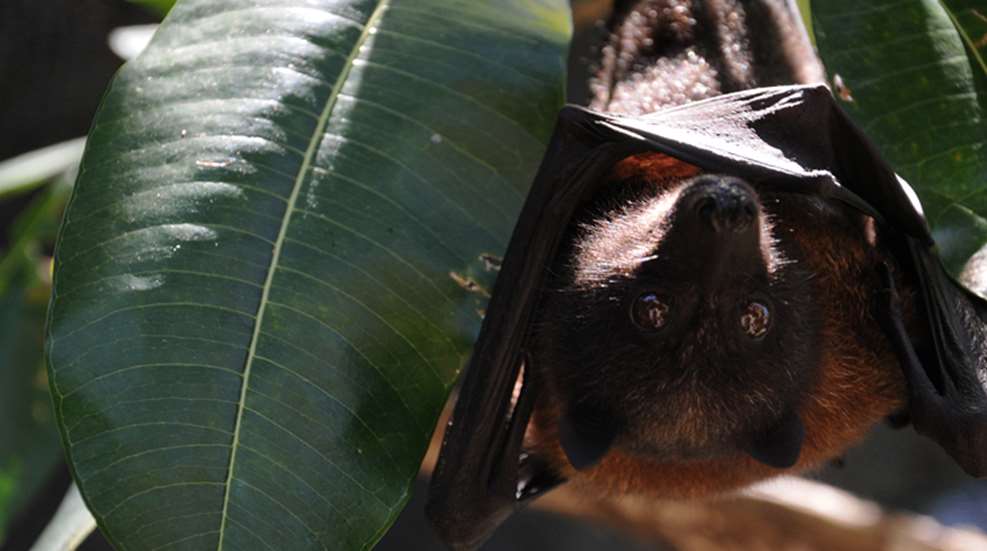
It's nearing Halloween, and the eldritch outlines of bats are to be found everywhere—fashioned from construction paper and affixed to your 'fridge door, crafted in realistic rubber and hanging from haunted-house attractions, or just etching themselves across the gloaming sky as the sun sets in your neighborhood. Most of us don't really think about bats at all, save to indulge in an atavistic shudder as we contemplate making accidental contact with a squeaky airborne rat in the dark. Give them a closer look, though: These critters are far more interesting than they are disgusting. Here are nine things you probably didn't know about bats.
1. Bats are not rodents.
Although we casually referred to them as "flying rats" above, bats are actually not members of the order Rodentia at all. In fact, they have an order all to themselves, Chiroptera, which means "hand wing."
2. Most bats are not blind.
Although the phrase "blind as a bat" has permanently entered the lexicon and is likely never to leave, the truth is that most bats aren't blind at all. In fact, the larger bats can see as well as (or even better than) a human. However, because they tend to be nocturnal, they don't rely heavily on their vision: Bats use echolocation—navigating using sound waves—to hunt, fly and socialize. Almost all bats echolocate, but the technique is also used by porpoises, toothed whales, a few shrews and two kinds of birds.
3. A bat can tell you if you're getting old or not.
The vocalizations that bats use to echolocate are extremely high-pitched—most adults can't hear it. However, because children under the age of eight have a much wider hearing range than adults, many children can hear bats as they navigate.
4. You'd rather be bitten by a vampire bat than a mosquito. Trust.
Yes, vampire bats are real. There are three species of them that will feed on the blood of animals, all located south of the U.S. in the region from Mexico to Argentina. They tend to prefer to feed on sleeping livestock and birds, but they can and do bite humans on occasion. If that concept creeps you out, consider this: You are many millions of times more likely to sicken or die from the bite of a mosquito than from a vampire bat. Although bats can carry rabies, only about half of one percent do...and the disease tends to render them unable to fly or hunt effectively. Mosquitoes, on the other hand, carry dengue, yellow fever, malaria, the Zika virus and other diseases that are responsible for millions of deaths worldwide every year.
5. You want as many bats in your backyard as possible. No, really.
Different bats eat fruit, nectar, meat, fish or blood, but insects are the most common target...and that's a good thing. These critters function like airborne vacuum cleaners, depopulating undesirable insects. The little brown bat can eat 1,200 night-flying insects in a one-hour period! (Want to encourage this around your home? The Organization for Bat Conservation can help you build your own bat house.)
6. Well, that doesn't sound so crazy, does it?
Regardless of a certain popular phrase regarding a bat's metabolic byproducts, there are perfectly useful applications for it. Bat excrement, or "guano," is aged and sold as high-phosphorus organic fertilizer.
7. They may not have a cool utility belt, but they do have superpowers.
You probably know that bats are the only mammals that can truly fly. (Other mammals, like the flying squirrel, don't really fly under their own power—they glide.) What you may not know is that vampire bats can also sense infrared waves, which they use to locate "hot spots" in their warm-blooded prey. The only other vertebrates capable of sensing infrared are snakes like pit vipers.
8. Save the bat, save the world.
Fruit-eating bats, such as those that live in rainforest environments, are a key part of the way plants spread their seeds. The bats eat the fruit, the seeds remain undigested, and when they're...uh, deposited...those seeds hit the ground along with a nice source of natural fertilizer. According to the National Forest Service, bats are responsible for the pollination of over 300 types of fruits and vegetables.
9. Bat medicine. Bat medicine, is what I need. Oh, oh, oh...
Vampire bats have an anti-clotting enzyme in their saliva that they use to keep their blood meal flowing. They have to; their teeth are actually quite small and their bite is superficial enough that many animals people don't even notice when they're bitten. (What's more, they only take about a teaspoonful at a time.) This anti-clotting enzyme is being studied to help produce blood thinners for use in human medicine.
We hope that you've enjoyed this list of little-known bat facts, and apologize if any of it has given you the willies. (But as far as the Bon Jovi song that's going through your head now? Sorry, not sorry.)






































